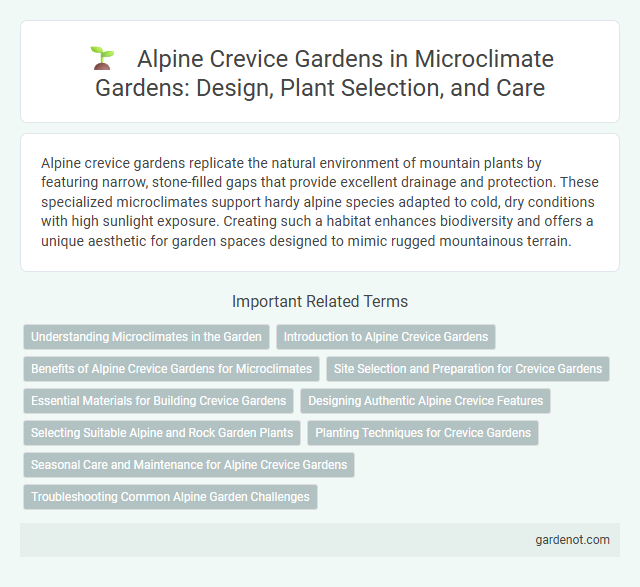Alpine crevice gardens replicate the natural environment of mountain plants by featuring narrow, stone-filled gaps that provide excellent drainage and protection. These specialized microclimates support hardy alpine species adapted to cold, dry conditions with high sunlight exposure. Creating such a habitat enhances biodiversity and offers a unique aesthetic for garden spaces designed to mimic rugged mountainous terrain.
Understanding Microclimates in the Garden
Alpine crevice gardens leverage unique microclimates created by closely spaced rocks, providing ideal conditions for drought-tolerant and cold-hardy plants native to mountainous regions. The crevice's depth and orientation influence moisture retention, temperature fluctuations, and sunlight exposure, enabling specialized plant species to thrive in otherwise challenging environments. Understanding these microclimate variables is essential for replicating natural alpine conditions and promoting plant health and biodiversity.
Introduction to Alpine Crevice Gardens
Alpine crevice gardens replicate the natural rocky fissures found in high mountain environments, providing ideal microclimates for specialized alpine plants. These gardens emphasize well-drained, nutrient-poor substrates and precise rock placement to mimic natural crevices, promoting plant health and growth. Creating an alpine crevice garden supports biodiversity by accommodating rare, drought-tolerant alpine species adapted to extreme conditions.
Benefits of Alpine Crevice Gardens for Microclimates
Alpine crevice gardens create ideal microclimates by mimicking natural mountain environments, providing excellent drainage and temperature regulation for sensitive plants. These gardens promote biodiversity by supporting specialized alpine species that thrive in narrow rock fissures with minimal soil. Their design reduces water usage and shelters plants from wind and extreme weather, enhancing plant resilience in challenging microclimates.
Site Selection and Preparation for Crevice Gardens
Alpine crevice gardens thrive in well-drained, rocky sites with full sun exposure and protection from harsh winds, replicating natural mountain environments. Site selection should prioritize areas with good air circulation and soil pH between 6.0 and 7.0 to support alpine plant health. Preparation involves constructing deep, narrow crevices filled with a mixture of coarse sand, gravel, and organic matter to ensure excellent drainage and mimic natural rock fissures.
Essential Materials for Building Crevice Gardens
Essential materials for building Alpine crevice gardens include durable natural stones such as limestone or sandstone, which provide stable microhabitats and excellent drainage critical for alpine plants. High-quality, well-draining soil mixes enriched with sand and grit support root aeration and prevent waterlogging. Incorporating materials like gravel and small pebbles enhances moisture retention and mimics the natural rocky environment, creating the ideal conditions for crevice garden plant species.
Designing Authentic Alpine Crevice Features
Designing authentic alpine crevice gardens requires replicating the natural rocky habitats found in high mountain regions, emphasizing narrow, deep fissures filled with well-draining, gritty soil. Selecting hardy, drought-tolerant alpine plants such as saxifrage, edelweiss, and cushion plants ensures survival in microclimates with intense sunlight, fluctuating temperatures, and limited moisture. Incorporating locally sourced stones with varied textures and strategic orientation mimics natural crevices, promoting optimal root growth and microclimate stability for alpine flora.
Selecting Suitable Alpine and Rock Garden Plants
Selecting suitable alpine and rock garden plants for an alpine crevice garden involves prioritizing drought-tolerant, cold-hardy species that thrive in well-drained, rocky soil with minimal nutrients. Key plant choices include Saxifraga, Alyssum, and Sempervivum, which excel in narrow crevices and harsh microclimates due to their compact growth and deep rooting systems. Incorporating native alpine species enhances ecological adaptation and supports microhabitat biodiversity within the garden.
Planting Techniques for Crevice Gardens
Alpine crevice gardens require meticulous planting techniques that mimic natural rocky habitats by placing plants within deep, narrow slots in well-draining substrates. Selecting drought-tolerant alpine species with compact root systems such as saxifrages, sedums, and sempervivums enhances survival in these microclimate conditions. Proper orientation and layering of stones create temperature gradients and moisture retention zones essential for thriving crevice plants.
Seasonal Care and Maintenance for Alpine Crevice Gardens
Seasonal care for Alpine crevice gardens involves regular inspection and removal of dead foliage to prevent disease and promote healthy growth. In spring, apply a balanced fertilizer to support new shoots, while ensuring soil is well-drained to avoid root rot during wetter months. Winter protection includes mulching with grit or fine gravel to insulate delicate plants from extreme temperature fluctuations.
Troubleshooting Common Alpine Garden Challenges
Alpine crevice gardens often face challenges such as poor drainage, root rot, and nutrient deficiencies, which can stunt plant growth. Ensuring well-drained, gritty soil and using rocks to create natural crevices promotes healthy root systems and prevents waterlogging. Regular monitoring for pests like aphids and fungal infections, combined with appropriate aeration, supports thriving alpine plants in microclimate garden settings.
Alpine crevice garden Infographic

 gardenot.com
gardenot.com